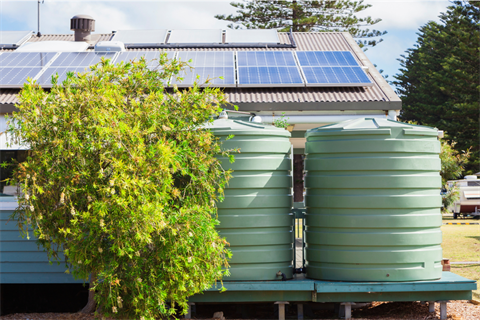How to make sure your rainwater is safe to drink
Published on 31 January 2024

Rainwater tanks are a common sight in the Kempsey Shire, with many residents capturing and storing rainwater for a variety of household uses.
In urban areas, where residents are connected to a town water supply, authorities recommend that captured rainwater is used for non-drinking purposes such as watering gardens, pool and spa filling, car washing, toilets, showers and laundry.
This is because town water undergoes extensive testing and filtering to ensure it is safe to drink, unlike your rainwater tank.
However, if you live out of town, away from town water supplies, then capturing and storing rainwater for your household needs is often your only option.
Drinking your rainwater is safe, as long as you are aware of some basic maintenance tasks.
Keep your roof and gutters clean
Leaves, dust and debris accumulate on roofs and gutters, which will block water from getting to the tank, cause your gutters to overflow, as well as decrease the quality of water pouring into the tank.
Roof catchments and gutters should be cleared of leaves and other debris every three or four months, and overhanging branches removed, preferably before heavy rain occurs.
Screen water tank entry points
There are three main outlets for your tank which all need to be screened to stop debris, mosquitoes, frogs, rodents, lizards and other creatures from entering who would like to make your tank their home:
- Tank inflow: the hole in the top of your tank where the water flows in.
- Tank overflow: the hole on the upper wall of the tank which allows water overflow when the tank is full.
- Tank outlet: small hole located on the lower wall of the tank where a valve or tap is located.
All of these openings need to be covered in mesh - to keep mosquitoes out, it is important that the mesh holes are 1mm or less and made of a quality non-degradable stainless steel.
First flush devices
A roof can accumulate dust, bird droppings, leaves, and even burnt particles from a chimney if you have a fireplace inside your home.
The first flush, especially after a dry period, can wash all of this accumulated debris straight into your tank.
To prevent this from happening, you can either disconnect the tank inlet for the first run off or install a first flush device which prevents the first portion of the runoff from entering the tank.
Cleaning your rainwater tank
Even with the most thorough gutter and roof cleaning regimen, your rainwater tank will need to be cleaned at least every 2-3 years.
If the rainwater tank becomes contaminated (dead frogs, rodents etc) a tank clean and addition of water treatment should be implemented as soon as possible, and water not consumed until this takes place.
One method of cleaning out your tank is to siphon out the sludge at the bottom of the tank, and the other is to completely empty the water out of the tank and shovel out the sludge that has accumulated.
It is possible to clean your own tank, but it is a dangerous job with a number of risks, including working in confined spaces and restricted access points in and out of the tank.
Professional tank cleaners are recommended.
Surface water
Water from dams, rivers and creeks should not be used for drinking, cooking or bathing without appropriate treatment. although this water is generally acceptable to use for washing clothes, irrigation, gardening and toilet flushing.
NSW Health warns that heavy rainfall and flooding increases the risk of contaminated water which could contain disease causing micro-organisms, chemicals or algal blooms, entering surface waters such as rivers and creeks. Blue-green algae may cause skin irritation. Water quality may be affected during drought as flow and the amount of water is reduced.
For more information check out the NSW Health guidelines on drinking surface water here: Drinking surface water - Water quality (nsw.gov.au)
Groundwater
Groundwater should not be used for drinking, cooking and personal hygiene (including brushing teeth and bathing) without testing and appropriate treatment.
Groundwater is water that comes from below the earth's surface, generally accessed via bores, spearpoints, springs or wells. In rural areas, these water sources may be high quality if the source is well maintained and protected. However, groundwater can be contaminated with sewage, animal waste, agricultural run off and pollution, as well as naturally occurring minerals such as arsenic.
For more information check out the NSW Health guidelines on drinking surface water here: Groundwater - Water quality (nsw.gov.au)
If the rainwater tank is servicing food preparation or accommodation facilities, a quality assurance program (QAP) is generally required. Please contact Council if information is required for food/accommodation businesses which rely on rainwater tanks. Go here for more information on private water supply guidelines.(PDF, 874KB)
For more information on tank water maintenance and cleanliness, the NSW Health website page on rainwater tanks.